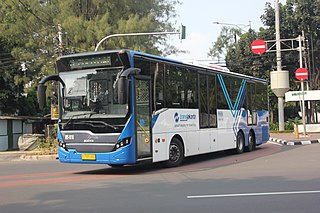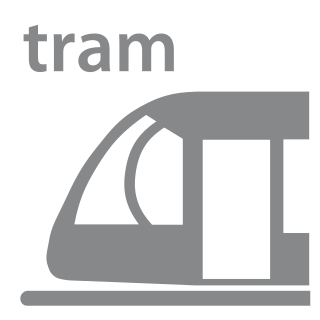
Light rail transit (LRT) is a form of passenger urban rail transit characterized by a combination of tram and rapid transit features. While its rolling stock is similar to that of a traditional tram, it operates at a higher capacity and speed and often on an exclusive right-of-way. In many cities, light rail transit systems more closely resemble, and are therefore indistinguishable from, traditional underground or at-grade subways and heavy-rail metros.

Bus rapid transit (BRT), also referred to as a busway or transitway, is a bus-based public transport system designed to have much more capacity, reliability and other quality features than a conventional bus system. Typically, a BRT system includes roadways that are dedicated to buses, and gives priority to buses at intersections where buses may interact with other traffic; alongside design features to reduce delays caused by passengers boarding or leaving buses, or paying fares. BRT aims to combine the capacity and speed of a light rail transit (LRT) or mass rapid transit (MRT) system with the flexibility, lower cost and simplicity of a bus system.

A rush hour or peak hour is a part of the day during which traffic congestion on roads and crowding on public transport is at its highest. Normally, this happens twice every weekday: once in the morning and once in the afternoon or evening, the times during which most people commute. The term is often used for a period of peak congestion that may last for more than one hour.

Calgary Transit is the public transit agency which is owned and operated by the city of Calgary, Alberta, Canada. In 2019, an estimated 106.5 million passengers boarded approximately 1,155 Calgary Transit vehicles. It operates light metro (LRT), urban tramway, bus rapid transit (BRT), para-transit, and regular bus services. In 2023, the system had a ridership of 144,385,200, or about 463,000 per weekday as of the fourth quarter of 2023.

The Transitway is a bus rapid transit (BRT) network operated by OC Transpo in Ottawa, Ontario, Canada. It comprises a series of bus-only roadways and reserved lanes on city streets and highways. The dedicated busways ensure that buses and emergency vehicles on the Transitway rarely intersect directly with the regular traffic, and make it possible for them to continue at full speed even during rush hour. OC Transpo operates a network of rapid routes which use the Transitway to connect communities with the O-Train light rail system. Additional bus routes also use segments of the Transitway.

Guided buses are buses capable of being steered by external means, usually on a dedicated track or roll way that excludes other traffic, permitting the maintenance of schedules even during rush hours. Unlike railbus, trolleybuses or rubber-tyred trams, for part of their routes guided buses are able to share road space with general traffic along conventional roads, or with conventional buses on standard bus lanes.

The State Transport Authority (STA) was the government agency which controlled public transport in South Australia between 1974 and 1994.

The Grenoble tramway is the tram system in the city of Grenoble in the Rhône-Alpes region of France. In 1987, Grenoble became the second French city to reintroduce trams, the first being the Nantes tramway. The current network is 35-kilometre (22 mi) long, and comprises five lines: lines A, B, C, D and E. Line A was opened in 1987, line B in 1990, line C on 20 May 2006, line D in October 2007 and line E on 28 June 2014.

The Nantes tramway is a tramway system operating in the city of Nantes in Pays de la Loire, France. The first tramway in Nantes opened in 1879 and closed in 1958 due to bombing damage during World War II, while the present tramway was re-introduced to the city in 1985.

The Nice tram is a 27.5-kilometre (17.1 mi), triple-line tram in the city of Nice in Provence-Alpes-Côte d'Azur, France. It is operated by the Société nouvelle des transports de l'agglomération niçoise division of Transdev under the name Lignes d'azur.

The Ticket t+ is the standard single trip ticket for Paris public transit. It can be bought from ticket machines or staffed counters, but not on board buses. As of 2024, it is available as a single paper ticket at the price of €2.15. Since 2019, the ticket can also be loaded onto a reusable Navigo Easy card, which can be purchased for €2 at staffed ticket counters and select ticket vending machines. When using Navigo Easy, the ticket is also available as a pack of 10 at a reduced price of €17.35. Starting 2021, Île-de-France Mobilités is in the process of phasing out the use of paper tickets, and as of September 2023 has discontinued offering a carnet discount for paper tickets. A reduced-price carnet is available for children under 10 years old and some other groups for €8.65.

A bi-articulated bus or double-articulated bus and sometimes train-bus, tram-bus, trackless tram or double bendy bus is a type of high-capacity articulated bus with an extra axle and a second articulation joint, as well as extended length. Bi-articulated buses tend to be employed in high-frequency core routes or bus rapid transit schemes rather than in conventional bus routes.

The Strasbourg tramway, run by the CTS, is a network of six tramlines, A, B, C, D, E and F that operate in the cities of Strasbourg in Alsace, France, and Kehl in Baden-Württemberg, Germany. It is one of the few tram networks to cross an international border, along with the trams of Basel and Geneva. The first tramline in Strasbourg, which was originally horse-drawn, opened in 1878. After 1894, when an electric-powered tram system was introduced, a widespread network of tramways was built, including several longer-distance lines on both sides of the Rhine.

Semitan is the company responsible for the comprehensive public transport network of Nantes Métropole, the urban community of the French city of Nantes. The network operated by Semitan is marketed under the name and logo TAN and this abbreviated form is also sometimes used to refer to the company. Semitan is itself an acronym for the Société d'Economie Mixte des Transports de l'Agglomération Nantaise. The TAN network comprises three Tramway lines, two Busway lines, an extensive network of buses, an airport shuttle bus line, two Navibus lines and a night bus network. A single common fare system covers all these modes and also extends to suburban trains within the Métropole boundaries, although these trains are not operated by Semitan.

CTfastrak is a regional bus rapid transit system currently operating between downtown Hartford and Downtown New Britain station in New Britain in central Connecticut. Operated by Connecticut Transit, it is the first bus rapid transit system in Connecticut and the second in New England after the MBTA Silver Line. CTfastrak opened on March 28, 2015 after fifteen years of planning and three years of construction.

Navibus is a group of water bus routes in the French city of Nantes, operated as part of the Tan urban transit network that also includes buses and trams. Routes operate on both the River Loire and the River Erdre, and accept the full range of standard Tan tickets.

The Rabat–Salé tramway is a tram system in the Moroccan agglomeration of Rabat and Salé cities which opened on 23 May 2011.

The South East Hampshire Bus Rapid Transit is a 3.4 kilometres (2.1 mi) unguided busway between Gosport and Fareham in the county of Hampshire, the road itself is called Henry Cort Way and is named after an ironware producer. The busway scheme is sponsored by Hampshire County Council using the route of the former Fareham to Gosport Line to reduce congestion on the parallel A32 between the towns.

Bus rapid transit creep is a phenomenon where bus systems that fail to meet the requirements for being considered "true bus rapid transit" are designated as bus rapid transit regardless. These systems are often marketed as a fully realized bus rapid transit system, but end up being described as more of an improvement to regular bus service by proponents of the "BRT creep" term. The Institute for Transportation and Development Policy published several guidelines in an attempt to define what constitutes the term "true BRT", known as the BRT Standard, in an attempt to avert this phenomenon.
Transport in Copenhagen and the surrounding area relies on a well-established infrastructure making it a hub in Northern Europe due to its road and rail networks as well as its international airport. Thanks to its many cycle tracks, Copenhagen is considered one of the world's most bicycle-friendly cities. The metro and S-train systems are key features of the city's well-developed public transport facilities. Since July 2000, the Øresund Bridge has served as a road and rail link to Malmö in Sweden. The city is also served by ferry connections to Oslo in Norway while its award-winning harbour is an ever more popular port of call for cruise ships.

























